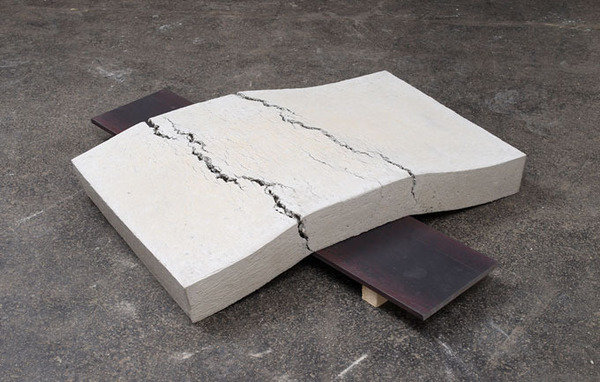Christoph Weber
dal 28/1/2015 al 13/3/2015
Segnalato da
28/1/2015
Christoph Weber
Galerie Rosemarie Schwarzwaelder, Wien
Sculptural Bodies. The exhibition presents sculptures that could be (mis)understood as artistic models for tectonic processes, but this would be too one-dimensional a reading for his artistic material.

Vienna-based artist Christoph Weber chose the tongue-in-cheek title “Not yet titled” for a concrete floor
sculpture gently laid on a steel plate, thus playing with the idea of the moment when something is determined,
i.e. takes form. Weber is fascinated by the qualities of concrete; it is “his” material. The artist is drawn to its
malleability, its ability to be processed, and its inherent creative potential. He takes full advantage of the
process of drying and curing, manipulating the concrete’s form for his sculptures while subjecting it to different
forces: laying it on a steel plate, tipping it over, letting it collapse. These movements are always visible in his
sculptural bodies. The work becomes a kind of frozen or hardened process.
With their folds and faults, Weber’s sculptures could be (mis)understood as artistic models for tectonic
processes, but this would be too one-dimensional a reading for his artistic material. Concrete is inevitably
associated with industrial processes used in architecture and is a quintessential example of the promises of
Modernism. “Concrete” was also a term used by the “no future” generation of the late 1970s to describe the
ossification of bourgeois society. Artistic materials are thus never neutral; their potential to create meaning
remains inscribed in the finished objects. Works made of concrete evoke metaphors of violence and power.
Weber expands on these associations in the formal processes he initiates – adding decisive moments of
vulnerability or fragility, for example – condensing his sculptures into multifaceted metaphors that oscillate
between power and impotence, creation and destruction.
In terms of formal characteristics, Weber’s sculptures can be traced back to artistic traditions that had their
breakthrough in the exhibition Live in Your Head. When Attitudes Become Form in 1969 in Berne, when the
notion of the artwork as an artifact was fundamentally challenged by process-related approaches. This
postminimal spirit was recently recaptured in the exhibition Post / Postminimal in the Kunstmuseum St. Gallen
in 2014, which brought works from Postminimalism together with sculptures by contemporary artists.
Provoking social change and overthrowing an artistic canon are no longer the main concern of today’s artists.
They are interested first and foremost in redefining material qualities and subject matter in art. Contemporary
artists like Christoph Weber naturally build on the formal research of past artists and combine this with today’s
experiences. They create works that develop their own sensitivity while confidently exploring the possibilities of
contemporary sculpture. Thomas Trummer calls Weber’s concrete works a kind of a “stress test for the
thingliness” that brings something vital to contemporary art – a double perspective that focuses on both
material and thematic qualities. The eminently present-day aspect of Weber’s artistic works is thus founded on
the interconnectedness of these qualities. While his sculptural bodies address their own material foundations,
they also serve as metaphors for the human condition in a world that Gerhard Polt so poignantly describes as a
“paradise of colorful concrete.”
Konrad Bitterli
Image: Christoph Weber, not yet titled, 2014, concrete, steel, wood, 18 x 105 x 125 cmi
Press Contact: i
David Ulrichs, david@david-ulrichs.com
Opening: Thursday 29 January 2015, 7pm
Galerie nächst St. Stephan Rosemarie Schwarzwälder
Grunangergasse 1
Wien



